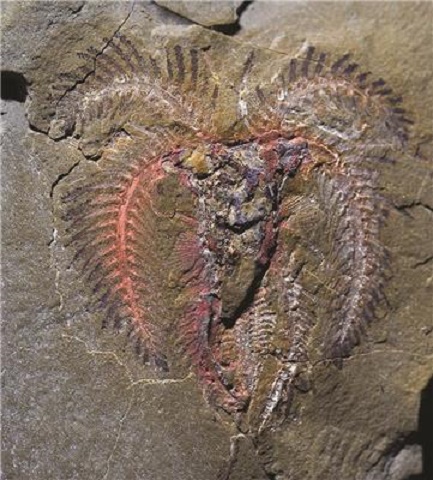Some of the oldest marine animals on the planet, including armoured worm-like forms and giant, lobster like sea creatures, survived millions of years longer than previously thought, according to a spectacularly preserved fossil formation from southeastern Morocco.

[Credit: Marianne Collins, ArtofFact]
The Lower Fezouata formation has been revealing exciting discoveries about life in the Ordovician -- around 485 -- 444 million years ago -- since its discovery just five years ago.
'The Fezouata is extraordinarily significant' says Professor Derek Briggs of Yale University, co-author of a study published today in the Journal of the Geological Society. 'Animals typical of the Cambrian are still present in rocks 20 million years younger, which means there must be a cryptic record in between, which is not preserved.'

which range to the Devonian [Credit: Peter Van Roy]
Over 160 genera have already been documented from the Fezouata, with much more expected to be found. They include animals which would have looked perfectly at home during the Cambrian: armoured lobopodians -- worm like creatures with spines on their backs and short, stubby legs, and anomalocaridids -- huge segmented animals with remarkable feeding limbs, which are some of the largest marine creatures of the time.
As well as demonstrating the longevity of fauna thought to have been extinct millions of years previously, the Fezouata proves that other creatures evolved far earlier than previously thought.

the fused segments at the rear characteristic of
living horseshoe crabs [Credit: Peter Van Roy]
'Horseshoe crabs, for example, turn out to be at least 20 million years older than we thought. The formation demonstrates how important exceptionally preserved fossils are to our understanding of major evolutionary events in deep time' says Peter Van Roy, also of Yale, who first recognised the scientific importance of the Fezouata fauna and is lead author of the study, part of a project funded by the National Science Foundation.
The spectacular preservation, which includes detailed soft parts and organisms over 2 metres in length, is thanks to the fine grained, muddy sediments in which the organisms were preserved.

three dimensions within a concretion. Two sets of swimming flaps are
evident on the left side of the trunk [Credit: Peter Van Roy]
'These are special rocks' says Professor Briggs. 'Some of the organisms are enormous -- several metres in length. With such exceptional preservation, in a fully marine exposure, we can develop a reasonably full picture of what marine life looked like in the Ordovician.'
The discoveries suggest the 'Great Ordovician Biodiversification Event' -- an explosion in diversity throughout the earlier part of the Ordovician period -- may have been a continuation of the Cambrian explosion.

[Credit: Marianne Collins/ArtofFact]
'There is much more to learn from the Fezouata' says Professor Briggs. 'Why do we not see more assemblages like this in the Ordovician? What ecological changes happened at the Cambro-Ordovician interval? Are the Cambrian Explosion and the Great Ordovician Biodiversification Event separate, or phases of the same event?'
Source: Geological Society of London [July 07, 2015]